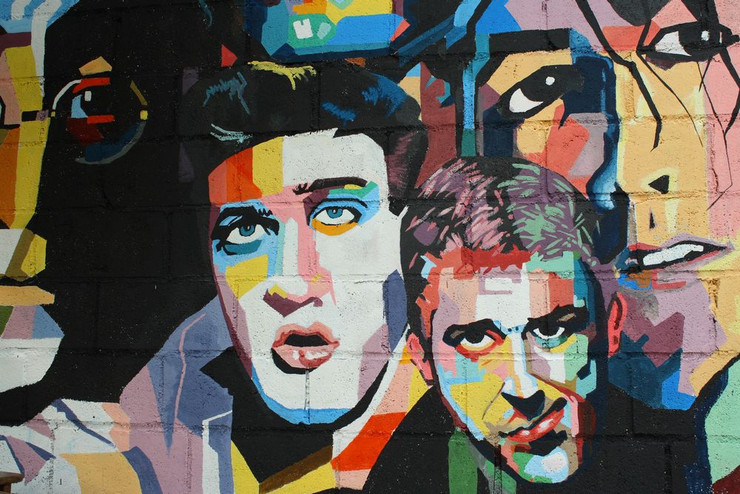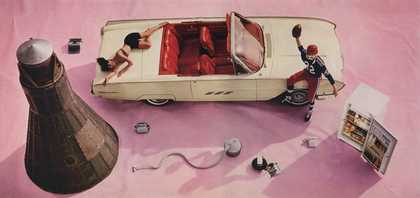A Bold, Bright Rebellion That Changed the Art World Forever

Pop Art is more than simply a vibrant aesthetic; it's a cultural movement that completely upended the art world. Pop Art, which emerged in the middle of the 20th century, effectively used consumer culture, celebrities, and commonplace objects to create striking visual messages.
Pop Art is easily recognized for its vivid colors, strong shapes, and lighthearted attitude, as seen in Roy Lichtenstein's comic-style paintings and Andy Warhol's soup cans. However, underlying its lighthearted façade comes a biting indictment of contemporary life, celebrity, and consumerism.
Describe Pop Art in detail, and explain why it is still important today. We should investigate.

The large-scale street art "Saw, Sawing" by Claes Oldenburg
A Brief History of Pop Art
The 1950s and 1960s saw the rise of Pop Art as a response to the abstraction and solemnity of modern art movements such as Abstract Expressionism. Pop artists resorted to the iconography of popular culture, including advertisements, comics, celebrities, and brand logos, whereas older artists concentrated on emotion and spontaneity.
Pop Art in Britain

Marilyn in the Sky (1999) by James Gill
British artists like as Richard Hamilton and Eduardo Paolozzi started experimenting with collage and popular media in the early 1950s. Their art challenged the expanding American cultural influence in postwar Europe as well as the role of consumerism.
Pop Art was famously defined by Hamilton as: "Popular, disposable, inexpensive, mass-produced, youthful, gimmicky, glamorous, and Big Business."
Pop Art in America

USA American Pop Art
The 1960s saw the explosion of Pop Art in the United States. Artists such as Robert Rauschenberg, Jasper Johns, Roy Lichtenstein, and Andy Warhol rose to prominence. They adopted mass manufacturing methods, such as screen printing, and frequently used recurring pictures to simulate the monotonous nature of advertisements.
The famous quote from Warhol was: "Being a machine is my goal." His studio, The Factory, was designed like a factory and became a center of renown, creativity, and celebrity culture.
Key Features of Pop Art
Pop Art has a distinct visual language. Here are the main elements that define it:
1. Everyday Subjects- Commonplace items, such as comic strips, soda bottles, and soup cans, were transformed into artwork by pop artists. The notion that art must deal with lofty or somber subjects was called into question by this.
2. Bold Colors & Clean Lines- Pop Art is easily identified by its use of vivid, saturated hues that are frequently delineated with crisp, graphic lines.
3. Mass Production Techniques- The relationship between art and mass production was emphasized by the widespread use of commercial printing techniques like screen printing by Pop Artists.
4. Celebrity Culture- The fixation with celebrity and identification was reflected in the regular coverage of icons such as Mickey Mouse, Marilyn Monroe, and Elvis Presley.
5. Irony & Satire- Pop Art frequently straddles the boundary between adoration and criticism. In addition to being vibrant and entertaining, it poses queries regarding celebrity, consumerism, and artistic originality.
Key Artists and Works
Here are a few major figures and their iconic contributions to Pop Art:
Andy Warhol

Liz 1964 - Andy Warhol - Pop Art
Famous works of Andy Warhol include Marilyn Diptych, Brillo Boxes, and Campbell's Soup Cans. Warhol blurred the distinction between fine and commercial art and transformed mass production into an art form.
Roy Lichtenstein

Look Mickey (1961).
Well-known for: Drowning Girl, Look Mickey, and Whaam!. In order to create dramatic and satirical scenarios, Lichtenstein used hand-painted Ben-Day dots to emulate comic book images.
Richard Hamilton

Richard Hamilton photograph for the cover of living art magazine
Known for: What exactly is it about modern homes that makes them so charming and unique?
Hamilton studied household life and consumer culture as a pioneer of Pop Art collage.
Claes Oldenburg

Known for: Massive sculptures of commonplace items, such as spoons, clothespins, and hamburgers. Oldenburg elevated the commonplace into the spectacular through the use of material and size.
Pop Art’s Legacy and Influence
Pop Art's influence extends far beyond the 1960s. It laid the foundation for many later art forms, including:
Contemporary Pop & Neo-Pop
Pop Art's themes and style are incorporated into fine art by artists such as Jeff Koons and Takashi Murakami, who also combine pop culture, fashion, and media.
Design, Fashion, and Advertising
Graphic design, fashion, and branding were all greatly impacted by Pop Art. Its striking images are still utilized in everything from apparel to commercial packaging.
Social Media Culture
Pop Art seems more relevant than ever in a society where visuals, celebrity influencers, and branding rule the landscape. Its observations on consumption, repetition, and fame reflect the state of the digital world today.
Final Thoughts: Pop Art Then and Now
Pop Art transformed our understanding of art. It showed us that anything can be an artistic medium, including comic books, celebrities, and soup cans. It allowed generations of artists to investigate identity, celebrity, and consumerism while also obfuscating the distinction between high and low culture.
Pop Art continues to influence how we currently see art and culture, regardless of whether you consider it to be humorous, critical, or both.
Remember Pop Art, which is still making waves decades after it was first created, the next time you see a well-known brand or face repeated on a gallery wall.
Join our classes to enhance & improve your memory skills and let your child unlock the power to retain information from every moment of his/her life!
